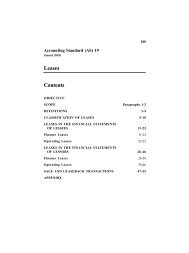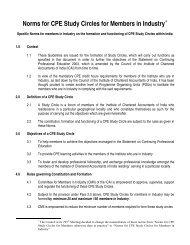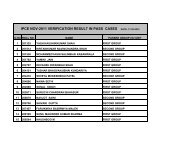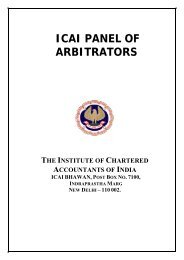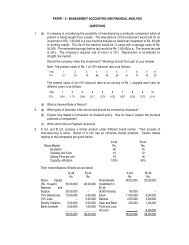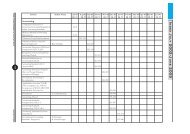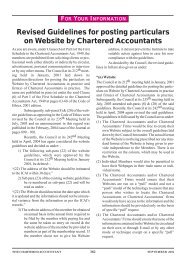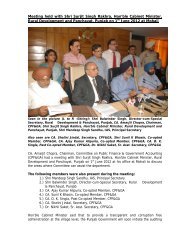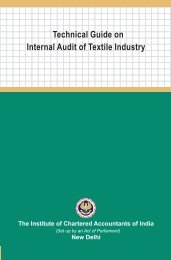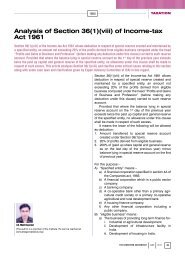The Chartered Accountant
The Chartered Accountant
The Chartered Accountant
Create successful ePaper yourself
Turn your PDF publications into a flip-book with our unique Google optimized e-Paper software.
GLOBAL PERSPECTIVE<br />
A well-functioning disclosure and regulatory environment, an infrastructure<br />
that supports timely, accurate, and clear communications to investors, coupled<br />
with an educated investor population, will be able to reap the benefits of<br />
mortgage securitization and avoid the worst of the risks. Lastly, following<br />
accounting rules, having high quality audits, making timely provisions for<br />
bad debts, and writing down impaired assets are all old lessons but even<br />
more critical in the new economy.<br />
filing for bankruptcy protection in April 2007. Over<br />
150 prime and subprime lenders also failed in 2007. 15<br />
By 2008, the MBS themselves started to tarnish. Mortgages<br />
had been combined into varying funds, and so<br />
it was extremely difficult to gauge which MBS or even<br />
which companies were susceptible to the subprime<br />
defaults. <strong>The</strong> value of all MBS became suspect, and<br />
just about every financial institution had some MBS<br />
on their books. While buyers of credit default swaps<br />
were making money, CDS sellers were taking a hit.<br />
Soon banks were unwilling to lend to each other because<br />
they were not sure if the other bank had a big<br />
exposure to subprime loans and CDS. By September<br />
2008, banks stopped lending to each other at even<br />
high interest rates. When there is substantial risk of<br />
the principal not being returned, a high interest rate<br />
is not sufficient inducement for potential lenders to<br />
part with their money. <strong>The</strong> widespread uncertainty<br />
froze credit markets, and banks were unable to meet<br />
their current obligations. What followed next was an<br />
unprecedented and spectacular failure of financial institutions.<br />
Two investment banks that were among the most<br />
deeply leveraged in MBS were the first to go. In<br />
March 2008, Bear Sterns was rescued by JP Morgan<br />
Chase in a deal brokered by the New York Federal<br />
Reserve Bank; in September Lehman Brothers, a<br />
158-year old institution, filed for bankruptcy. After<br />
Lehman failed, the floodgates opened on insolvencies.<br />
Fannie Mae and Freddie Mac, which owned or<br />
guaranteed over 50% of the $12 trillion US mortgages,<br />
were taken over by the US government. Bank of<br />
America stepped in to rescue Merrill Lynch. <strong>The</strong> US<br />
Federal Reserve extended an $85 billion loan to help<br />
AIG meet their obligations on all those credit default<br />
swaps. That amount has since grown to $150 billion<br />
and the eventual amount could be higher. Washington<br />
Mutual, in the largest bank failure ever in the United<br />
States, was seized by the Federal Deposit Insurance<br />
Corporation (FDIC), while Wachovia bank was acquired<br />
by Wells Fargo.<br />
Investment banks were vulnerable to the downturn<br />
in mortgage values for several reasons. <strong>The</strong> first was<br />
that investment banks, unlike retail banks, do not<br />
typically have a lot of capital. <strong>The</strong>y buy and sell, borrow<br />
and lend, making money on the transaction and<br />
trading fees. <strong>The</strong>y are not allowed to take deposits so<br />
they depend on fee-based and trading-based income<br />
and on loans to finance purchases and investments.<br />
It took three to nine months to securitize the MBS,<br />
so when the downturn came, many investment banks<br />
were left holding warehoused mortgages that had significantly<br />
declined in value or had no market at all. If<br />
they had financed the purchase of those mortgages<br />
with borrowing, they had to pay back the money they<br />
had used to buy mortgages they could no longer sell<br />
or securitize, creating a severe and acute cash crunch.<br />
Adding to their difficulties, investment banks whose<br />
client contracts required them to buy back the CDOs<br />
that they had guaranteed scrambled for cash or credit<br />
to meet their obligations. Investment banks were also<br />
obligated by contract to finance several SPEs. <strong>The</strong>y<br />
had planned on raising money with short term instruments<br />
such as commercial paper, but their access to<br />
such credit dried up when no one was willing to lend<br />
to a bank.<br />
<strong>The</strong> contagion extended to traditional banks that had<br />
MBS and CDS on their books as well. When the news<br />
spread that banks were in financial difficulties, the loss<br />
of confidence caused a run on several institutions,<br />
and some in the United States and Europe became<br />
insolvent. <strong>The</strong> ones that were solvent were anxious<br />
to sell their MBS to meet their liquidity needs but the<br />
MBS started trading at steep discounts, well below<br />
the value they would realize if held to maturity. <strong>The</strong><br />
lack of buyers and the anxiety to sell drove the prices<br />
of MBS down very rapidly. Mark-to-market (MtM)<br />
accounting rules, which required firms to record the<br />
fair market value on assets and liabilities, acted in a<br />
pro-cyclical manner to exacerbate the decline in the<br />
prices of MBS. John Berlau, director of the Center<br />
for Entrepreneurship at the Competitive Enterprise<br />
Institute and a free market proponent, likened the<br />
MtM rules to a “method of disease transmission,”<br />
15 Krishna Palepu, Suraj Srinivasan, and Aldo Sesia Jr., “New Century Financial Corporation,” HBS No. 109-034, (Boston: Harvard Business School Publishing, 2008).<br />
THE CHARTERED ACCOUNTANT 1011 DECEMBER 2008



